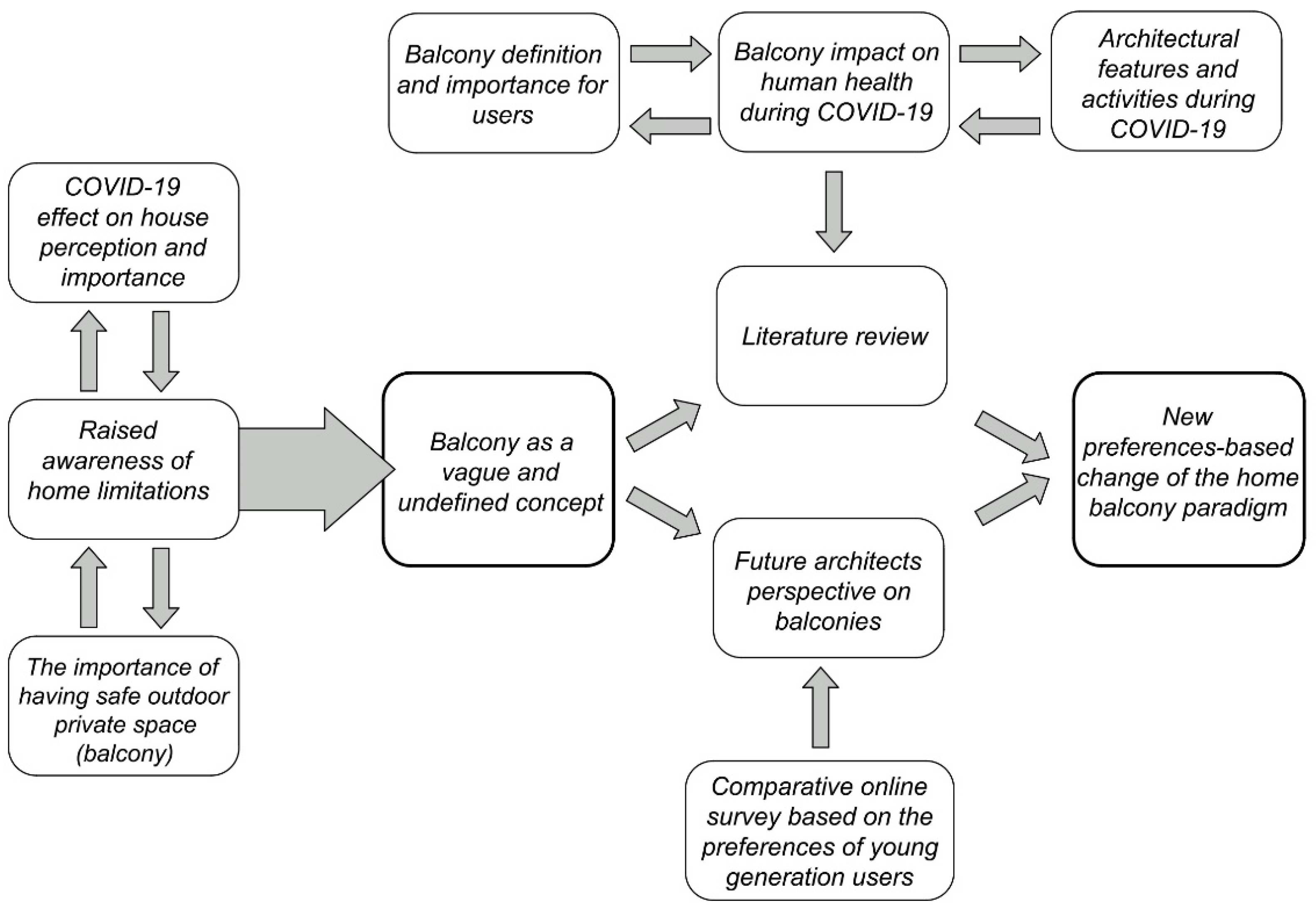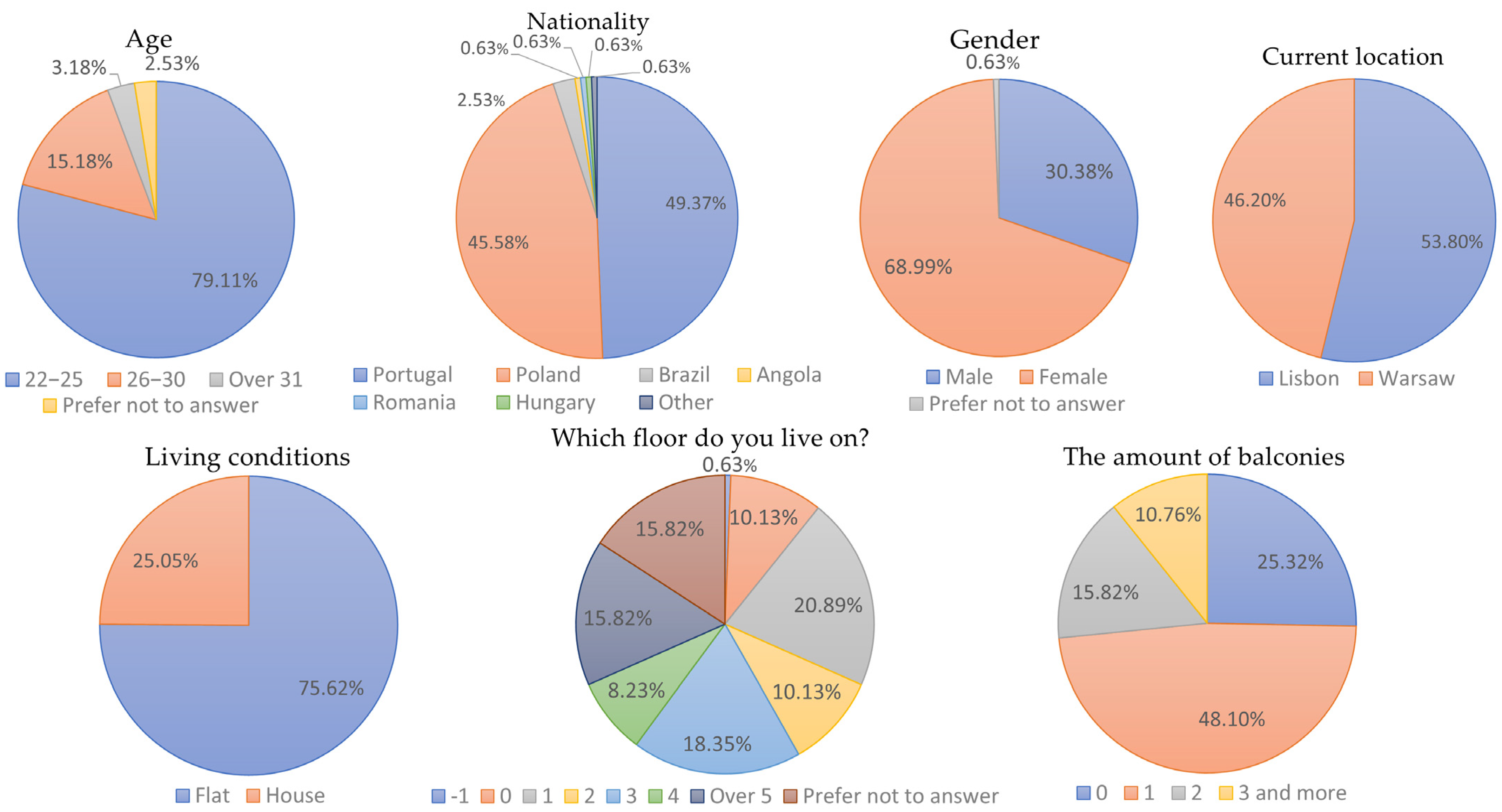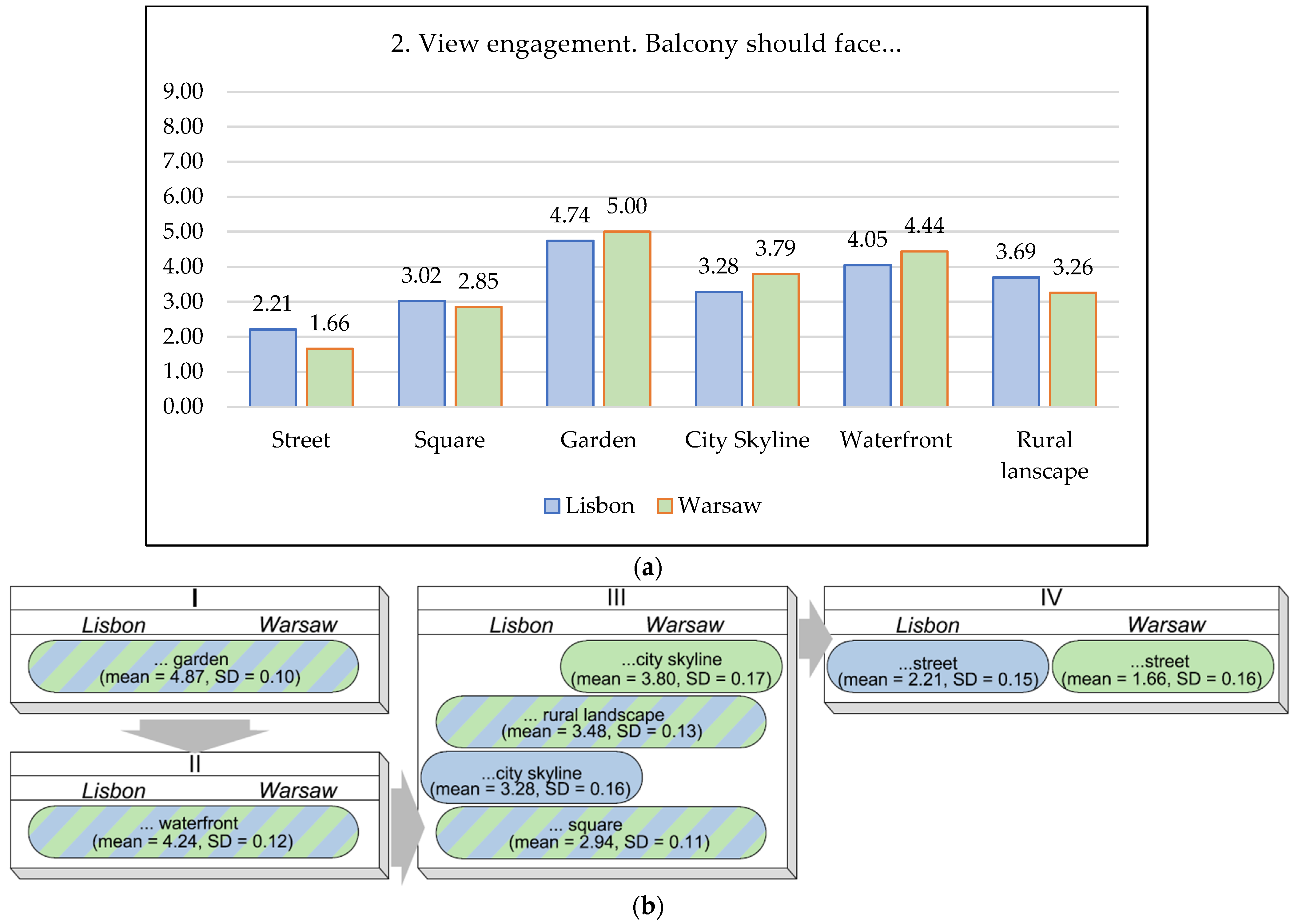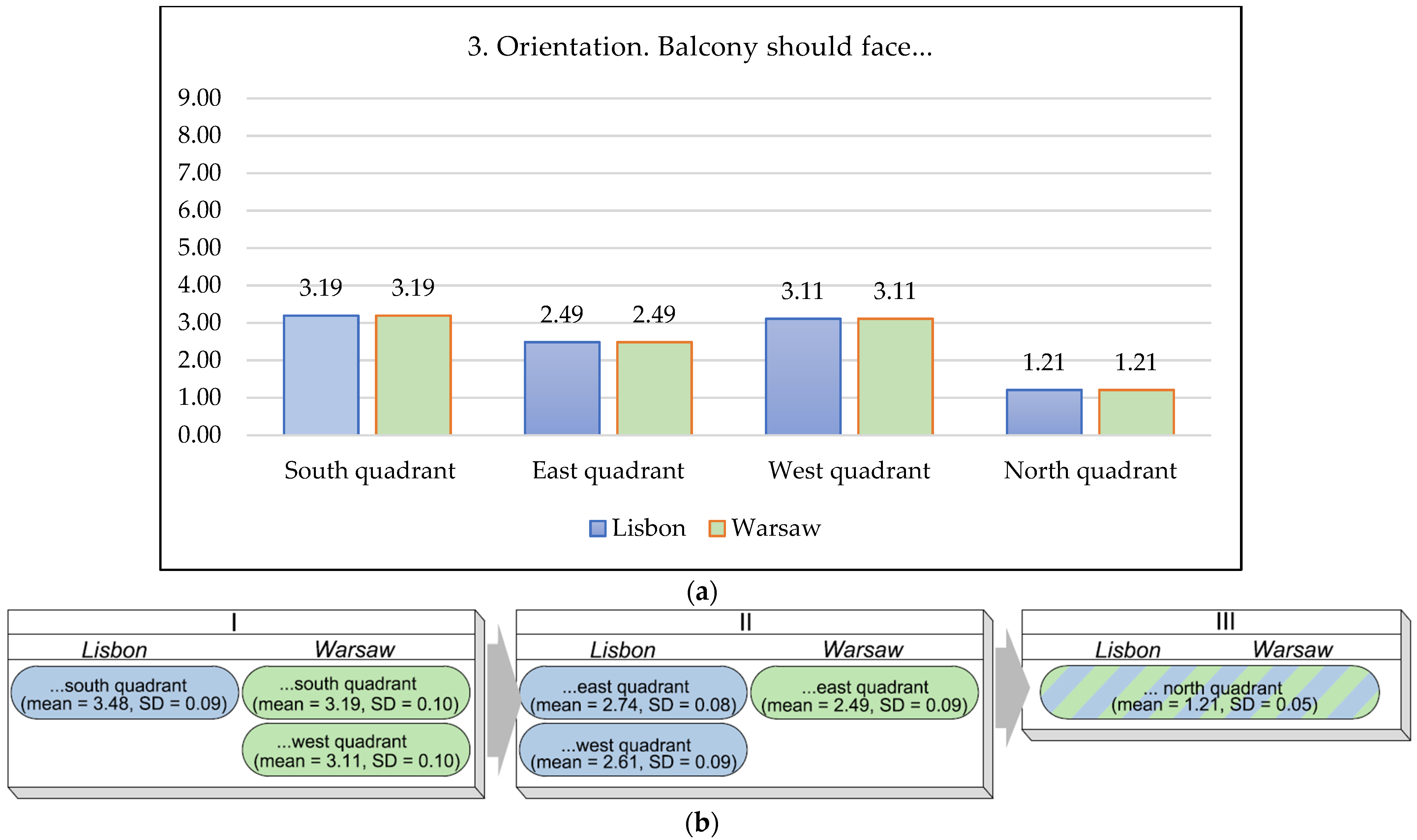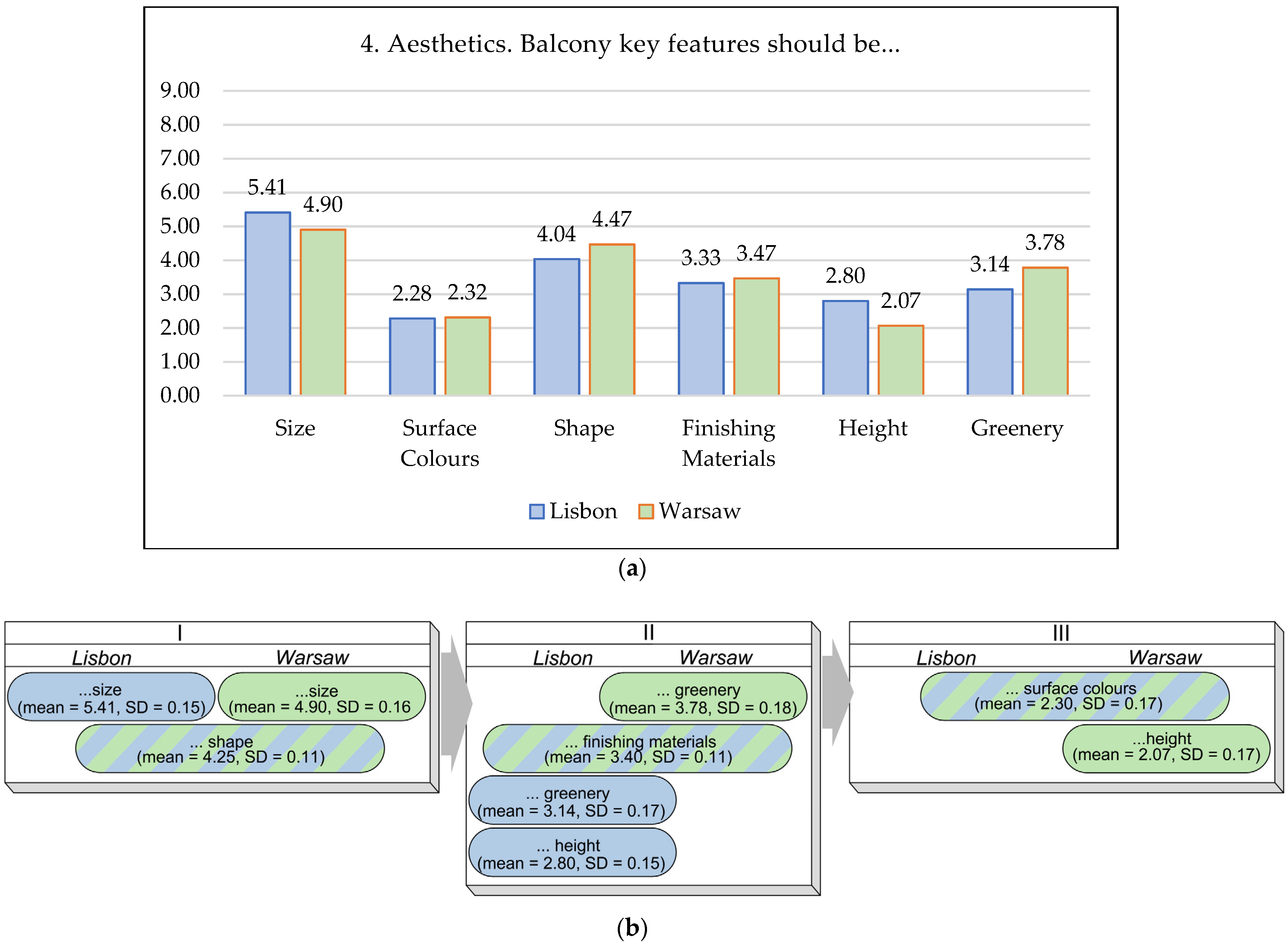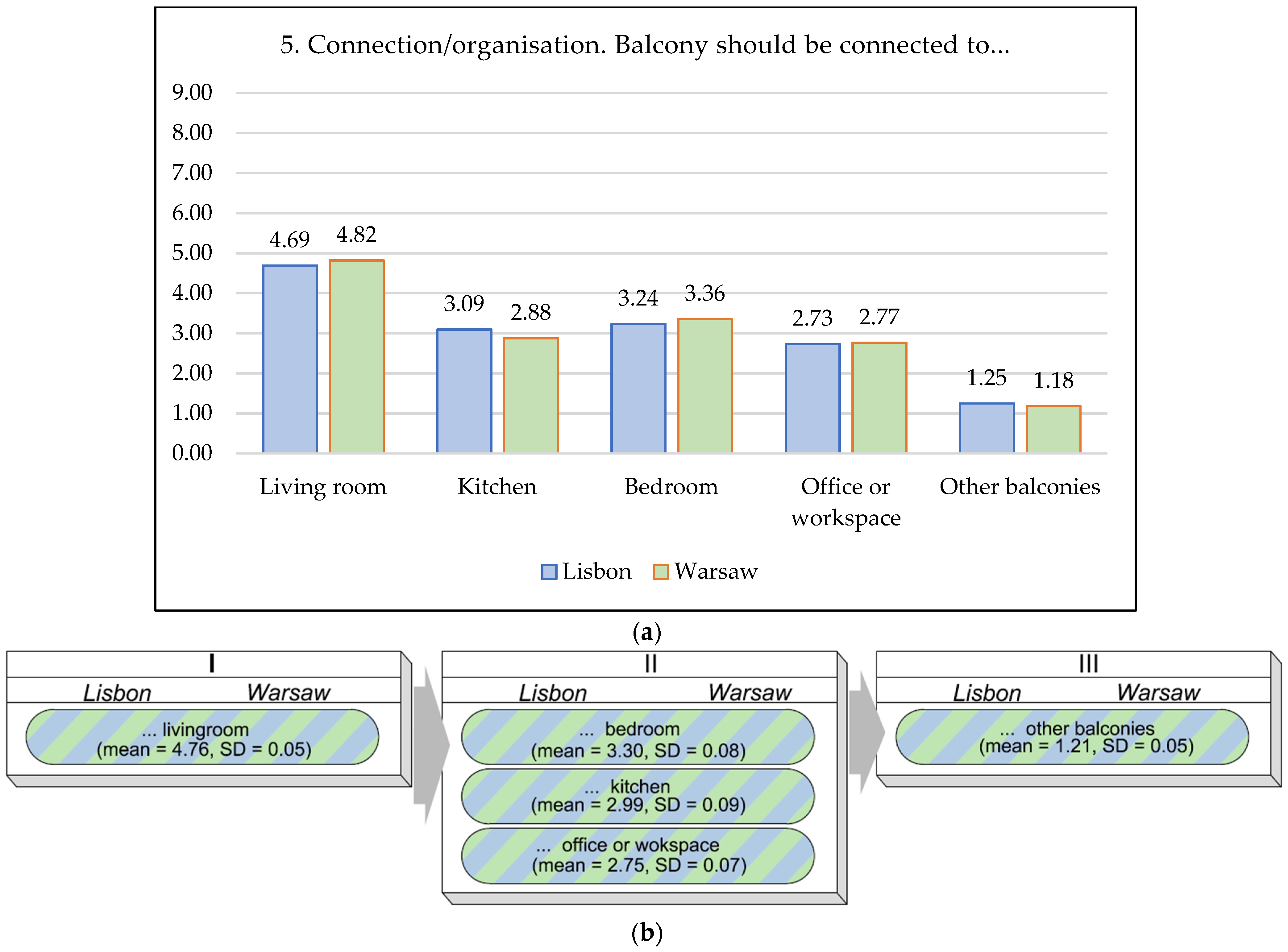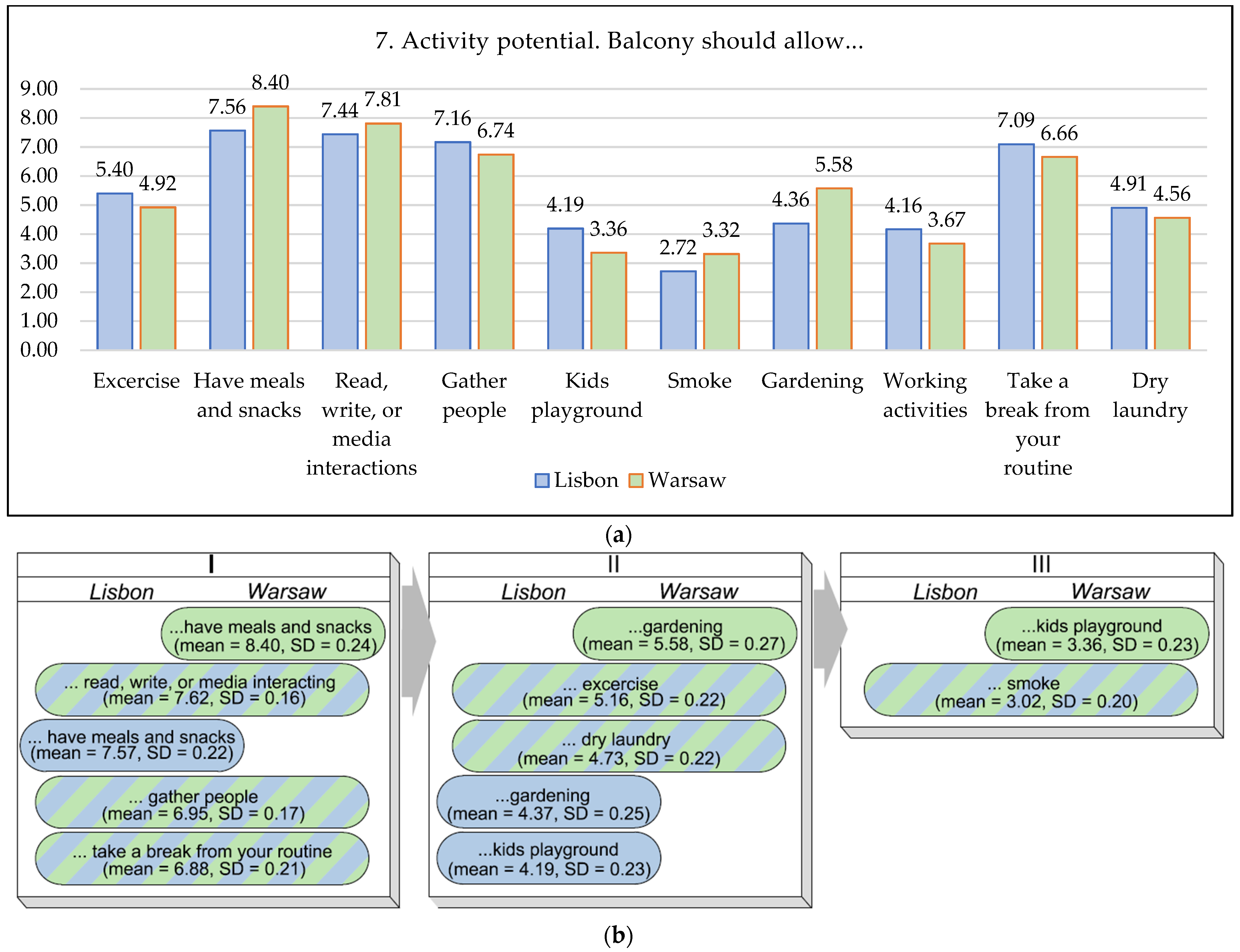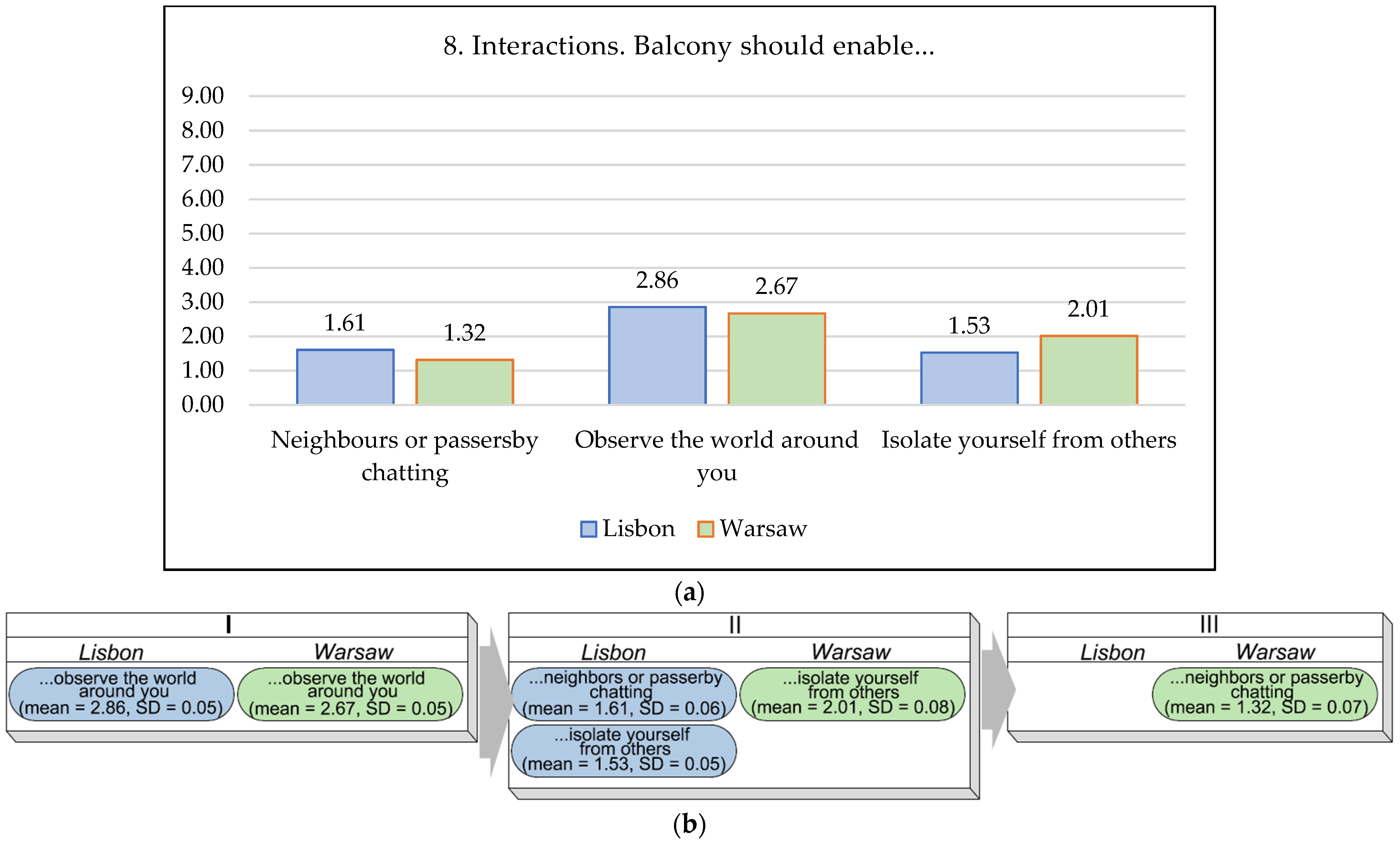1. Introduction
Architecture is a mirror of the life and social behaviour of each era [
1]. The implications of health-promoting factors, such as sun, light, noise, air quality, or ventilation were a vital issue in the design research scope in the past and are still today in the contemporary world [
2]. With the COVID-19 pandemic lockdowns, the already deep wound in the daily life of European citizens increased, as people living in heavily populated metropolitan areas were deprived of outdoor recreational space and restricted to the borders of their homes 24/7 for several weeks [
3,
4]. This situation was even worse in overcrowded and inadequate dwellings, usually inhabited by the most fragile population fringe with restricted or no access to a safe private outdoor space in times of great uncertainty [
5]. In addition to the harmful effect on physical and mental health [
6], the lockdown periods change the paradigm of how people relate to their home by becoming aware of its limitations [
3,
7]. Then, emerges the concept that home boundaries expanded toward the inside, changing multiple times the meaning of “home” and “…people relied on existing and emerging aspects of home interconnectedly, material and immaterial alike, to re-construct the idea of home in order to convert a compulsory adjustment to an agreeable experience” [
8] (p. 10). Two phenomena had a significant contribution to this matter. The first is due to the pressure of remote work policies (e.g., increasing telework) that require a workplace within the “home” boundaries (e.g., office) and, consequently, an indoor layout redesign/redefinition [
9,
10]. The second stems from the amount of time spent at home, which increased the importance of having a safe, private outdoor space (e.g., balcony, terrace, or garden) whose features enable physical and mental escape, outdoor leisure time, and contact with the external surroundings [
7,
11,
12]. As history informs us, this type of “awakening” and its call for change occurred in previous pandemics, as people pushed for new spatial designs to decrease the likelihood of viral infection [
10]. The balcony concept, in particular, was perceived as an element with several benefits as it brings light, fresh air, sun, shade, and recreation to people’s life [
13].
Therefore, the changes promoted by the pandemic shook the existing paradigm in the way indoor and outdoor living spaces are thought of [
12]; particularly, the balcony concept has gained new momentum and, consequently, a new vagueness. Its existence, functions, features, borders, and the relationship between the indoor space and the surroundings are now an unclear territory calling for clarification, particularly in European contexts. This issue impacts how the future balcony will be planned and designed, potentially affecting people’s quality of life and ability to withstand new pandemic events safely. The present study intends to fill this gap and open the discussion to the community (see
Figure 1 for theoretical framework understanding). Addressing the recommendations by Ribeiro et al. [
14] demanding further design studies on the subject, and in line with the “post-pandemic housing” research questions by Megahed and Ghoneim [
10], it is of interest to understand how the home balcony is perceived today, during pandemic times in European context, in the light of people’s needs concerning design issues and activities. Therefore, the present study proposes to assess the preferences of a selected group of key informants (KI) toward design features and activities performed on a balcony today.
The authors resort to a post-occupancy evaluation (POE) through an online survey to be conducted among Architecture master students at Lisbon School of Architecture—University of Lisbon, Portugal, and Faculty of Architecture, Warsaw University of Technology, Poland. Due to their academic background and training, the KI possess the skills and will to address this issue. In addition, they will be both users and designers of balconies throughout their professional careers. Their perspective and understanding provides valuable clues for future balcony design, paving the way for further experimentation in this field.
The survey intends to generate data concerning the balcony design features and activities according to the KI preferences. It allows for understanding and comparing users’ preference patterns in two locations with different geographies (southwestern European and central European, respectively), climates (according to the Köppen-Geiger classification, the climate in Portugal is temperate with dry summers and hot or warm summers (Csa, Csb) and in Poland, it is cold, without dry season and warm summers (Dfb) [
15]), and social contexts. In this way, the outcomes are not limited to only one place, but they can be extrapolated to the southern and central European countries, using the data from both locations. Furthermore, the outcomes are organised and grouped by patterns observed and analysed in a descriptive and interpretative way.
POE is a broad-scope qualitative technique for gathering occupants’ feedback on their behaviour, experiences, fears, and expectations concerning overall building performance. The collected data from users’ experiences assist architects, designers, and managers in assessing and improving the quality of an existing building condition [
16]. A survey in the form of a questionnaire has proven to be an accurate way of obtaining data for future analysis [
17]. In addition, an online method enlarges the research scope allowing for reaching participants dispersed by several locations (Lisbon and Warsaw in this case), while promoting sample diversification that increases the overall research quality and validity [
18]. As highlighted by Braun et al. [
18], the fact that the survey population target is acquainted with and comfortable using online platforms was also a reason to select this method over others.
1.1. Definition and Importance
A balcony is briefly defined as “an area with a wall or bars around it that is joined to the outside wall of a building on an upper level” [
19] (n.p.). In a more in-depth definition, it is a three-dimensional architectural prototype positioned on the exterior facade of a building belonging to a house private space that faces and opens to at least one side of the exterior through a protrusion or recession [
20]. It is a “space in between,” primarily of private character (indoor) but whose use implies a contact and connection with the public domain (outdoor) [
13,
20]; therefore, belonging to both realms [
21].
The importance of balconies as semi-private on the one hand, and semi-open on the other, where the private life of habitants might take place, rises in the new global conditions of the COVID-19 pandemic pushed by governmental restrictions. The last turn in the increased use of balconies comes with the fact that as non-specified and programmed areas, they can accommodate a wide range of activities [
13]. The constant possibility of using the balcony for different purposes makes them a place under continuous redefinition and re-establishment, enabling its use accordingly to new requirements and circumstances [
20]. Recent needs for social distancing increased the demand to exchange the outdoor social life by transferring the basic outdoor activities from the streets and sidewalks to isolated safe balconies giving birth, in 2020, to the new upcoming term “urban balconies.” The confinement rules collided with the European lifestyle, mainly felt in warm Mediterranean climates, where spending time outdoors (e.g., at coffee shops, terraces, squares, and gardens) was part of everyday life [
13].
During the pandemic, Molaei et al. [
7] state the availability of semi-private spaces as one of the factors to consider when evaluating life quality in cities, as balconies’ opened areas have the potential to develop a range of activities that improve everyday life, from enjoying leisure time, fresh air, and sun, to socialising with neighbours. Grigoriadou [
13] highlights the balcony’s significance as a place that connects primary daily requirements that have been foregrounded during the COVID-19 crisis by the lack of opportunities to use crowded outdoor spaces. Consequently, the value and importance of home balconies increased for users, since they spent more time there [
11], and for the real estate market that witnessed a price escalation of properties with balconies/terraces [
12].
1.2. Impact on Health and Well-Being
The Constitution of the World Health Organization (WHO) defines health as “…a state of complete physical, mental and social well-being and not merely the absence of disease or infirmity” [
22] (p. 1). Within the pandemic context, in what way is the WHO definition of “health” still valid and up-to-date? How does reducing social interactions (through telework) and making the everyday environment only indoors, locked in apartments, influence health and general well-being? In addition, how could balconies improve the quality of the time during lockdown periods? The answer to these questions seems clear, as the amount of time spent within the home borders increased and the impossibility of going out increased the demand for an outdoor semi-private space.
Architectural constraints, such as the absence of or poorly designed balconies, combined with a low-quality-built environment, contributed to the degradation of people’s mental health during confinements [
23]. Proof of this are the studies of Vieira and Meirinhos [
24] in Portugal, Millán-Jiménez et al. [
3] in Spain, and Amerio et al. [
23] in Italy. These authors concluded that people living in homes without an outdoor semi-private space, such as a balcony, terrace, or garden displayed worse mental health than the ones who do, showing feelings of “imprisonment” or the emergence of moderate to severe depressive symptoms, to name a few. A study by D’Alessandro et al. [
5] in Italy showed that dwellers under 30 and above 60 years old can have health benefits from being exposed to natural conditions (in a balcony, terrace, or garden) for 20–25 min a day. In the same line, a survey by Rodriguez-González et al. [
25] with 528 participants over 60 years old in Spain, showed that the elderly experienced some type of psychological damage in homes without open spaces or facing non-green areas, an issue that a well orientated and dimensioned balcony could ease. Moreover, Kley and Dovbishchuk’s statistical study in Germany concluded that the lack of a balcony or other semi-private outdoor space can be related to low life satisfaction (−2%). In addition, the absence of green urban areas nearby (an indicator of high-quality urban areas) could spark home relocation [
26]. In contrast, the online survey by Zhuo and Zacharias in China showed a negative correlation between having an outdoor semi-private space and social well-being, which can be explained by cultural factors and the increment of feelings of alienation from society in general [
27].
During the lockdowns in Portugal and Spain, this issue acquired even greater importance reaffirming the physical and psychological health benefits of increasing exposure time to greenery, natural spaces, and nature views [
28], as well as engaging in gardening activities [
29]. Being exposed to greenery can be achieved by having plants at the home, roof, or on balconies, a garden view rather than a street/square view, and most importantly, engaging in gardening activities even on small balconies [
30]; a scenario that feeds Mladenovic et al.’s [
31] (p. 39) vision of balconies becoming the “lungs of the city” in densely populated areas.
Given this, a balcony (semi-open area) appears to be both; an answer to provide safe outdoor access to its users and a challenge for architects and developers in charge of building design and retrofit [
11].
1.3. Design Roles, Features, and Functions
The architect and/or designer have the task of balancing the balcony’s functional and formal/compositional features, including its harmonious integration into the building’s facade [
32]. Additionally, a correctly designed balcony can enhance the overall building performance on several fields [
14]. It can provide privacy and acoustic shielding [
33,
34], improve thermal comfort, natural ventilation, and air quality [
35], lighting conditions, and glaring protection [
36], solar shading, and even reduce energy consumption [
37] and acclimatisation loads [
14]. On the ventilation side, the study by Omrani et al. [
38] assessed a balcony using a Computational Fluid Dynamics model considering its type, depth, wind angle and orientation, and concluded that the natural ventilation performance might improve up to 80% depending on design decisions. When it comes to decreasing energy consumption, Jamaludin et al.’s [
36] study focused on the potential of bioclimatic passive strategies in residential college buildings in Kuala Lumpur, Malaysia, and concluded that the use of balconies and patios not only improved indoor ventilation and lighting conditions, but also resulted in electricity savings (up to 90% per year considering all strategies) assessed on the Energy Efficiency Index over a 9-year period. At an acoustical level, Naish et al. [
33] assessed nine balcony types with several acoustic design variations (9720 tested scenarios) to determine the best solution depending on site conditions and specifications.
Simultaneously, the balcony design needs to be adaptable enough to be used all year round, accommodating different functions [
39]. In the Architects Data guidance [
40] (p. 295), the functions of a balcony are not dissociated from its design. In contrast, several proposals concerning the balcony dimensions and shape consider the furniture size (e.g., sunbeds, tables, and chairs), which suggests a possible range for activities to take place.
Due to size restrictions, most balconies do not have any specific function, usually performing ancillary activities, such as resting, observing the surroundings, or drying laundry, especially during periods of good weather. Often located next to the living room or kitchen, they serve as natural extensions for entertaining, dining, and relaxing. The possibility of creating a space for isolation or new needs, such as working, studying, and kids playground, highlights the balcony’s flexibility to accommodate different functions now and in the future [
5].
Among the limited number of publications addressing the issues of balcony design, activities, and usage in residential contexts during the pandemic, the authors highlight the weight that Middle Eastern countries have on this subject (see
Appendix A,
Table A1 for a summarised version).
In Turkey, 48.1% of the 160 participants in the Aydin and Sayar study showed that owning a home balcony was beneficial during lockdowns. In addition, its importance grew, as well as the time people spent on it engaging in different activities, although that depended on the balcony’s orientation, shape, and size. The latter was revealed to be a key factor, mainly due to the lack of functionality that small-sized balconies with narrow rectangular shapes display for the development of activities. Moreover, the most adapted balconies displayed larger areas (55.01% 4–6 m
2; and 68.20% 7–10 m
2) due to the spatial potential they inherently had [
11]. In the same country, Gür’s study of 500 respondents in Bursa aimed to assess the post-pandemic lifestyle changes, concluding that confinements had an impact on the time spent in outdoor semi-private areas (balcony and patios), where 35.7% of the participants stated using it for 1–2 h; 16.1% 3–4 h; 6.3% 5–6 h; and 4.5% more than 6 h per day. In addition, 4% revealed that they are using the balcony to receive guests and entertain, and 84% to air packages, clothes, and groceries [
41].
In Cairo, Egypt, Khalil and Eissa’s online survey with 160 respondents (snowball sampling) and 20 interviews (convenience sampling) aimed to detect the change in the use patterns in balconies before and during lockdowns. Throughout the confinements, 52% of the respondents used their balconies daily, an increase of 32.4% compared with the 19.6% who stated they were already using it before. Activities related to leisure and gathering increased in frequency; 73% versus 59.5%, during and before lockdowns, respectively; while the usual activities before the pandemic diminished, such as drying clothes and storage, the first, 50.7% to 39.2%, and the second, 12.2% to 8.8%. Other activities’ outcomes are worth mentioning, such as the increase in kids playground (+12.1%), exercise (+6.7%), working (+25.7%), and having meals (+3.4%) comparing both periods. The correlation between activities and balcony design features underlines its importance, namely its size, which constrains work and exercise workouts if less than 6 m
2, and kids playground if less than 4 m
2 [
21]. Moreover, in Cairo, ElZein and ElSemary’s study about the impact of the pandemic on the use and insight of home balconies, consisting of an online survey with 150 participants, stated that the balcony importance perception increased from 12% (before) to 44% (after) as well as its usage time (54% spent 0–20 min; 26% 21–60 min; and 14% up to 3 h). Regarding “accessibility,” 20% of respondents showed satisfaction with their balcony access; 44% said they prefer to enter from the living room, 24% from the reception, 17% from the bedroom, and 1.9% from other rooms. Time shortage was referred to as the most significant barrier to using the balcony by 41% of respondents, 38% indicated privacy concerns, and 22% had noise issues. The most carried out activities in balconies after lockdowns were socialisation (47.4%), followed by listening to music (36.7%), meditation (36%), and reading (28%). In contrast, smoking, taking in fresh air, praying, barbecues, and dog activities (all 0.7%) were the least carried out. Additionally, 28% of respondents upgraded the balcony, mostly with greenery (73%) and furniture (34%), and 17% showed availability to upgrade it in the future [
42].
In Tehran, Iran, Zarrabi et al. conducted an online survey with 632 apartment-living respondents considering a post-COVID-19 scenario, using Friedman and the mean test analyses method, and concluded that architectural design features positively affect mental health and stress relief. Among them, semi-open spaces, such as balconies or terraces, have a major role mainly when they are not designed as narrow pathways but exhibit higher depths, being one of the preferred and most valuable house features [
43]. Moreover, in Tehran, Akbari et al.’s questionnaire of 421 respondents during home confinement showed that size matters, as outdoor semi-private spaces larger than 5 m
2 improved people’s mental state and house satisfaction when compared with spaces with less than 2 m
2. Regarding this, 54.6% of the participants considered their terrace “very small or small”, 92.3% said 2 m
2 spaces are “small” and inadequate for gardening activities, and 85.8% indicated that 2–3 m
2 were not suitable for their needs. Only outdoor spaces with 3–5 m
2 registered an increase in satisfaction levels, with 30% regarding them as “large or sufficient” to hold activities [
44]. By the same token, in Erbil, Iraq, the study by Hasan et al. assessed the balcony architectural quality of 11 residential buildings in Nowruz through a survey and observation methodology with a total sample of 120 apartments. The authors concluded that square-shaped balconies around 7.7 m
2 allow for engaging in a wide range of activities (96%), in addition to cooking (8%), storing (96%), and drying clothes (100%) when compared with round longitudinal and narrow balconies which are considered dysfunctional and underused [
32].
In Europe, there is still a course of action regarding this subject which underlines the relevance of the present study. The authors could not find any relatable study conducted in Lisbon or Warsaw; nonetheless, two studies in the European context are worth mentioning. The first is the work by Katunský et al. in Germany and Slovakia concerning the requirements and preferences to create an adaptable quality living space with a survey of 120 respondents in three range groups (up to 35, 35–50, over 50 years old) processed by the ANOVA statistical method. The authors concluded that green urban areas were vital for the participants, with echo in other matters, such as the demand for a garden, terrace, or balcony. Moreover, 90% of the over 50 years old group respondents considered having a balcony with the same importance as having a bathroom. In comparison, the 35–50 years old group dismissed the balcony importance (9%) [
45]. The previous study was performed before the official COVID-19 pandemic declaration by the WHO.
The second, in Wroclaw, Poland, the study by Smektała and Baborska-Narożny during the pandemic used non-participatory observation of 3000 balconies and 41 interviews of key respondents (real estate agents and developers, architects, and residents) concerning the use of balconies in apartments related to social norms and design. The authors observed that, on average, 24.7% of the balconies were empty, 35.6% had plants, 23.1% furniture, 19.5% privacy protection, 13.8% solar protection, 16.8% storage cabinets, and laundry equipment in the same proportion, and 5.2% cleaning devices (p. 141). The most observed activities were home ventilation purposes (2353) and drying laundry (652), followed by relaxing and reading (111) and short- and long-period observations (173) (p. 141). Despite the fact that there is no relation between balcony size and the nature of activities, mainly due to the underrepresentation of large balconies in the study, balconies facing north (4%), with a waterplane view (10%) and larger sizes (5%) were the ones holding most of the observed activities. The interviews showed that a suitable balcony size must have at least 3.5 m
2 and 1.2–1.5 m depth, be south-oriented or west-oriented, and connected to the living room. The preferred shape is the “square” as long and narrow balconies constrain activities, such as gathering and socialising. Furthermore, design issues focus mainly on meeting safety requirements and architectural facade aesthetics, while balcony size is proportional to the apartment size. Concerning the latter, once again, size is a key feature, as people remark that larger balconies are adaptable to various functions, despite their expectations due to the poor standard offered by the market [
46].
As noted, while balcony size and shape are features widely referred to in almost all the mentioned studies, none of them extend their scope into aesthetics-related features, such as materials, finishes, or colours. In addition, only a few address greenery, orientation, and acoustic and thermal comfort subjects.
3. Results
Mixed Model Analysis of Variance shows the differences and similarities in how Lisboners and Varsovians rate certain balcony characteristics. The analyses show a significant within-subject effect for all questions, indicating that significant differences in preference for specific balcony features could be determined: F(3.47, 541.72) = 119.33, p < 0.001, η2 = 0.43; F(3.97, 1.00) = 66.29, p < 0.001, η2 = 0.30; F(2.72, 421.03) = 162.13, p < 0.001, η2 = 0.51; F(4.52, 705.80) = 81.32, p < 0.001, η2 = 0.34; F(3.17, 494.10) = 279.56, p < 0.001, η2 = 0.64; F(1, 156) = 7.58, p < 0.001, η2 = 0.10; F(7.39, 1152.71) = 78.00, p < 0.001, η2 = 0.33; F(1.64, 255.94) = 146.76, p < 0.001, η2 = 0.49. Bonferroni post hoc analyses allowed for ranking the balcony features in order and indicating which responses were rated significantly higher or lower in the group of preferences. For all but the fifth question, the analysis showed significant interaction effects, indicating that the results of the mean responses varied by residence: F(3.47, 514.72) = 11.16, p < 0.001, η2 = 0.07; F(3.97, 618.50) = 3.21, p = 0.01, η2 = 0.02; F(2.72, 421.03) = 6.41, p < 0.001, η2 = 0.04; F(12.212, 705.80) = 4.85, p < 0.001, η2 = 0.03; F(3.17, 494.10) = 0.92, p = 0.44, η2 = 0.01; F(1, 156) = 4.61, p = 0.001, η2 = 0.07; F(7.39, 8577.18) = 3.08, p = 0.003, η2 = 0.02; F(1.64, 255.94) = 14.18, p < 0.001, η2 = 0.08.
Depending on the resident’s location, pairwise comparisons enable precise examination in which scores there is a statistically significant difference. First, the authors checked in which questions there were significant differences in the mean between people from Warsaw and Lisbon. Then, they checked whether the differences in responses impacted the order of importance of each balcony feature. The answers to each question were ranked into three or four groups of preferences (I, II, III, and IV). The present analysis compares whether Varsovians and Lisboners rate the balcony features in a similar order. Each question is presented separately, followed by the graph illustrating each answer’s mean and the responses’ ranking diagram. The general combined response appeared when there were no significant statistical differences between the groups. When a significant difference occurred, the responses were divided between the city residents. The groups of preferences were arbitrarily divided in some questions based on mean differences and similarities (without considering the statistical differences).
In the first question, “Comfort” the analysis shows that Lisboners and Varsovians rate the following responses equally:
Enough natural shading and
warm sensation (second place) and
cooling sensation (third place;
p = 0.13,
p = 0.61,
p = 0.59; see
Figure 4 below). There are differences only in the responses
direct sunlight and
quiet place (
p < 0.001,
p < 0.001). Lisboners rate the answer
direct sunlight significantly higher than Varsovians. In both groups, this answer ranks in the first place. Varsovians display the answer
quiet place significantly higher in the rating. Consequently, Lisboners rank this answer as important in the second place, while Varsovians rank it as one of the most important next to the
direct sunlight.
In the second question, “View engagement” despite the differences between the response
street and
city skyline (
p = 0.01,
p = 0.03), both groups exhibit similar ranking values (see
Figure 5 below). The response
garden ranks in the first place, followed by
waterfront in both groups. In the third place, the respondents ranked
square,
city skyline, and
rural landscape together. It is worth mentioning that Varsovians rate
city skyline higher than Lisboners (
p = 0.03). Therefore, it should be noted that the difference between the answer
square and the
city skyline answered by Varsovians is already statistically significant (
p = 0.005). In the last position, the respondents place
street; however, Lisboners rate it higher than Varsovians (
p = 0.01).
Question three, “Orientation” shows differences in all responses except for the
northern quadrant (
p = 0.97); which is considered equally the worst orientation by all respondents (see
Figure 6 below). When comparing the cities’ responses to the
southern quadrant and
eastern quadrant, Varsovians rate them lower than Lisboners (
p = 0.04,
p = 0.04). The differences also relate
western quadrant, where Varsovians value this direction “higher” than Lisboners (
p < 0.001).
Furthermore, for people from Warsaw, the south quadrant and the west quadrant are the most preferred orientations (and there are no significant differences between these directions, p < 0.001). Both groups place the east quadrant in the second group of preference. For Lisboners, only the south quadrant is in first place, while the west quadrant is significantly lower (p < 0.001), ranking it in second place together with the east quadrant (p = 0.99).
In the fourth question, “Aesthetics” both groups rate
size with the highest score (see
Figure 7 below). However, Varsovians rate this answer significantly lower than Lisboners (
p = 0.02). By the lower mean of response, the difference between
size and
shape is not significant (
p = 0.91) for Varsovians. Although there is a statistically significant difference between Lisboners response
size and
shape (
p < 0.001), it was decided to place them together in the first place. In both groups, the
shape was equally rated (
p = 0.05). Varsovians rate
greenery higher than Lisboners (
p = 0.01). Since
greenery displays a mean similar to
finishing materials, both answers were jointly rated in the second place by Varsovians. However, there is no statistically significant difference between answer
shape and
greenery in Warsaw’s group (
p = 0.19). Lisboners rate the response
height significantly higher than Varsovians (
p = 0.001); it was no longer statistically different from the rest of the responses in the second place (
p = 0.47,
p = 0.99). Both groups rate
surface colours in the last place (
p = 0.32). Varsovians rate
height significantly lower (
p = 0.001), placing it next to
surface colours as the lowest in this group (
p = 0.99).
In the fifth question, “Connection/organisation” there are no significant differences between both groups, thus the overall results were considered and ranked (see
Figure 8 below). Commonly, the connection with the
living room is the top preference, followed by the
bedroom,
kitchen, and
office or workplace. The difference between
bedroom and
office or workspace response is statistically significant (
p < 0.001). However, the authors decide to place them together due to a similar mean value and no statistical difference between the response
bedroom-kitchen (
p = 0.25) and
kitchen-office (
p = 0.82). The response
other balconies is the least preferred option.
The overall result in the
sixth question, “Air quality,” indicates that people would rather feel the
clean and fresh air sensation than the
breeze feeling (
p < 0.001). However, on a group comparison, Lisboners place the initial results in a higher place (
p < 0.001), while Varsovians rate these two features equally (
p = 0.53) (see
Figure 9 below).
In question seven, “Activity potential” both groups’ preferences display mostly similar behaviour (see
Figure 10 below). Significant differences appear only in the responses:
Have meals and snacks,
kids playground, and
gardening (i.e., three questions out of ten).
Having meals and snacks and
gardening is more important for Varsovians than Lisboners (
p = 0.01,
p = 0.001). In contrast, Varsovians rate the importance of
kids playground lower than Lisboners (
p = 0.01). However, these differences did not affect the overall ranking of responses almost at all. Features on top preferences are the responses
have meals and snacks,
read, write or media interactions,
gather people, and
take a break from your routine, followed by
exercise,
gardening, and
dry laundry. The least important are working
activities and
smoke; only the
kids playground differs enough to rank the Lisbon response in second place and the Warsaw response in third.
The last question, “Interactions” shows differences in the rating of each answer (see
Figure 11 below). In the
neighbours or passers-by chatting and
observe the world around you, Lisboners rate significantly higher than Varsovians (
p = 0.002,
p = 0.01). On the other hand,
isolate from others is more important for respondents in Warsaw than in Lisbon (
p < 0.001). The latter rate
observe the world around you as the most important, and responses
neighbours or passers-by chatting, and
isolate yourself from others in second place together. In contrast, Varsovians’ top preference is
to observe the world around you. Since there is a statistical difference between the answers
isolate yourself from others and
neighbours or passers-by chatting (
p < 0.001), these features are in the second and third place, respectively.
4. Discussion
The study findings show similar outcomes despite the cultural, geographical, and climatic differences between Lisbon and Warsaw. In six out of eight questions (except for two and five), only one response differs in the group of preferences. For instance, in the “Orientation” question, Lisboners rank the south quadrant in first place and the east and west quadrants in second place, while Varsovians rank the south and west quadrants in first place and only the east quadrant in second place. The differences between these results may be due to the various amounts of sunshine per day/season; the west quadrant in Lisbon is usually uncomfortable during summer. The average results indicate that changes in climate between both locations have a minor influence on the functioning of the balcony.
Furthermore, there are minor statistically significant differences in the rating of selected responses, resulting in not changing the position between the group of preferences. There are three differences in four out of eight questions (three, four, seven, and eight). There are two differences in three questions (one, two, and six). There are no significant differences in the fifth question, and the groups shared the ranking.
This indicates that the differences between locations, such as social context, climate, and geographical features, do not play a major role in KI preferences concerning home balconies during pandemic times.
The results show that the use of balconies for resting and spending time with others increased, as well as people’s perception of how important those features are. Therefore, the trend of using balconies for dining, reading, gathering people, and resting is evident. In line with this, ElZein and ElSemary [
42] state that socialising was the highest-scored activity, followed by listening to music, meditation, and reading, which matches the present study outcomes, where read, write or media interactions, gather people, break from the routine, and observe the world around you were the most preferred ones. Smoking was the least carried-out activity matching the present study. In the same way, the outcomes match the results of the study by Smektała and Baborska-Narożny [
46] in Poland, where relaxing and reading, along with surrounding observations, were some of the most observed activities in balconies. On the opposite side, basic activities, such as drying laundry, are far from top preferences matching a tendency observed by ElZein and ElSemary [
42] and Khalil and Eissa [
21] to be used less frequently. A similar outcome is found in the latter author, reporting that during the pandemic, along with the increase in balcony usage, other activities emerged and took place (e.g., kids playground, exercise, working, and having meals). Furthermore, another reason contributing to the rising importance of having a semi-private space, such as a home balcony, is the evidence that it sustains physical and mental health benefits for its users compared with those who do not [
3,
23,
24,
26].
Therefore, the evidence points toward changes promoted by the COVID-19 pandemic which awakened users’ behaviour, and increased the use and importance of home balconies mainly due to the transfer of activities previously performed outdoors into this space.
As Khalil and Eissa [
21] (p. 10) state: “Before lockdown, the balcony was in a sense an abandoned/neglected space at home,” now, the paradigm is undergoing significant changes. The present study outcomes corroborate this idea as size and shape, followed by finishing materials, were the KI top preferences in the balcony “Aesthetics” question in both groups. Other authors already mention the importance of size, stating that balconies with more than 3 m
2 increase users’ satisfaction level [
44], and shape/ratio, as an essential feature since rectangular and narrow balconies are considered non-functional and sparsely used [
32,
43], restricting social and gathering activities [
11,
46]. On the connectivity level, the authors observed a similar pattern with ElZein and ElSemary’s [
42] study in Cairo. In both cases, respondents opt to connect the balcony with the living room and the bedroom. Nevertheless, the present study results show that the tendency to select the living room is higher than in the Cairo case (choose a connection with the living room and the reception). Finally, the KI preferences for a balcony oriented toward the sun (first place) and facing a garden or a waterfront (first and second place) also find echoes in literature, as stated by Katunský et al. [
45] related to balcony views, and Ribeiro et al. [
28] concerning the physical and mental health benefits of nature views. From the lens of an architect, this space with an unspecified function needs to be updated to address the spatial demand of the highest-ranked activities with new qualitative design standards ready to be used all year round, as recommended by Wågø et al. [
39] even before the pandemic.
In this way, it appears that home balconies must be updated to address these “new” requirements regardless of the dwelling size or price. Otherwise, balcony spaces may become obsolete, underused, and fail to add value to the property and to the overall life quality of its users [
7,
12].
The study results allow for understanding the preferences of Lisboners and Varsovians concerning the role of balconies’ architectural features and activities during the COVID-19 period. The study contributes, first, to understanding the newly established paradigm reinforcing that people’s perception and importance of balconies changed during the pandemic. Second, the deprivation of outdoor space due to a health emergency has a psychological impact that overrides any cultural, geographical, and climatic differences, as both locations displayed similar results in the survey. Third, it illustrates a set of preferences that the architect/designer should consider when designing or retrofitting a balcony. These reflect and respond to the current users’ needs framed by the perspective of future architects and house owners. Our ranking system approach informs the designer where to focus, in other words, on features with a higher rating preference, relegating to second-place features with a lower ranking. Finally, in the long run, the authors intend to develop an online and open-source balcony assessment tool, calibrated according to the site-specific context, that can guide design decisions, evaluate real-estate assets, or assist public and private stakeholders in policy development. The present study brings novelty to this field as it inquiries about architectural and design-related questions in the domains of aesthetics (e.g., finishing materials, surface colours, and greenery), orientation, and thermal and acoustic comfort, which are rarely mentioned by other related studies. Additionally, it compares two different geographical contexts during a pandemic which has never been conducted before on this specific subject. However, as future concerns, there is a demand for more studies, mainly from the moment when the WHO announces the end of the pandemic, to verify whether this paradigm persists or changes again.
Study Limitations
The authors acknowledge the selected KI quality framed within the study scope, purpose, and goals; however, there are constraints in the present study related to:
Demographics: Most of the KI live in urban contexts (Lisbon and Warsaw), and display, on average, a short age range;
Climate: Conducting the survey at a different time of the year (seasons) might have different results, even with the same group of respondents;
Statistics: The present survey recognises the topic and provides an overview of the statistically important factors. However, it compares the responses inside (within) the questions without measuring the difference in the impact of each response between the questions, and;
There is an absence of studies within the research scope in Lisbon and Warsaw, which did not allow for outcome comparisons with other periods (before and during the pandemic).
Future comparisons of similar survey outcomes from more countries will allow for more in-depth observations concerning these matters.
5. Conclusions
The present study intends to assess the key design features and related functions and activities that home balconies should present today, considering the impact of COVID-19 lockdowns on people’s perception and meaning of home. The authors conducted an online survey over KI preferences, which will be both users and designers of these spaces (Architecture master students) in two distinct contexts: Lisbon, Portugal, and Warsaw, Poland. Both locations registered similar outcomes despite the geographical, climatic, and cultural/social differences. These appear irrelevant during pandemic times when it comes to balcony preferences on design issues and activities.
The outcomes align with other related studies that confirm that people’s perception of home balconies’ importance has changed (increased) during the pandemic. The results show that balconies should be designed to accommodate activities, such as having meals and snacks, reading, writing, engaging in media interaction, gathering people, or simply taking a break from the daily routine. In summary, activities previously practiced elsewhere are now transferred into the balcony space, pressing for new dimensional requirements.
The implications of this type of study are broad, not only in building readiness for new pandemic events but also in users’ health, style, and overall life quality. The balcony became an essential feature for the overall dwelling quality, value, and users’ physical and mental health, especially in densely populated urban areas.
Given the scarcity of this type of research in Europe, as opposed to Middle Eastern regions, the authors underline its relevance as a catalyst to develop similar studies in distinct contexts: Other countries, locations (e.g., rural, countryside), scales, and building types (e.g., commercial or office). The moment after the pandemic ends will be crucial for assessing whether this new paradigm persists or changes again. Nonetheless, the present study shows a possible way forward in this field, in which the observation of elements and users’ preferences will shape the architectural-related features of balconies. Its ultimate research goal is to support the development of a balcony assessment tool (online and open source) capable of adapting to a specific context or housing market with the potential to guide design decisions, evaluate real-estate assets, or assist local public or private stakeholders in policymaking.
